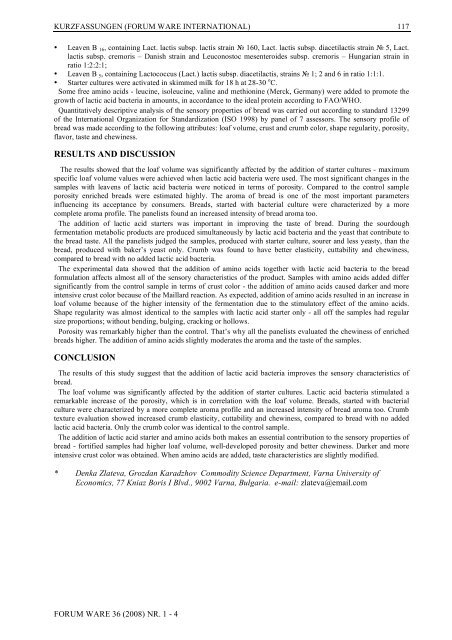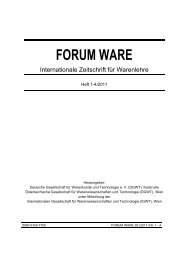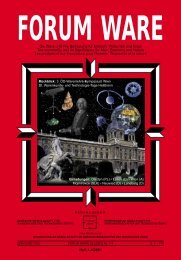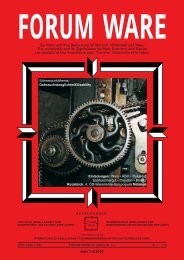Deutsche Warenkunde- und Technologie-Tage - DGWT
Deutsche Warenkunde- und Technologie-Tage - DGWT
Deutsche Warenkunde- und Technologie-Tage - DGWT
Erfolgreiche ePaper selbst erstellen
Machen Sie aus Ihren PDF Publikationen ein blätterbares Flipbook mit unserer einzigartigen Google optimierten e-Paper Software.
KURZFASSUNGEN (FORUM WARE INTERNATIONAL) 117<br />
• Leaven B 16, containing Lact. lactis subsp. lactis strain № 160, Lact. lactis subsp. diacetilactis strain № 5, Lact.<br />
lactis subsp. cremoris – Danish strain and Leuconostoc mesenteroides subsp. cremoris – Hungarian strain in<br />
ratio 1:2:2:1;<br />
• Leaven B 5, containing Lactococcus (Lact.) lactis subsp. diacetilactis, strains № 1; 2 and 6 in ratio 1:1:1.<br />
• Starter cultures were activated in skimmed milk for 18 h at 28-30 o C.<br />
Some free amino acids - leucine, isoleucine, valine and methionine (Merck, Germany) were added to promote the<br />
growth of lactic acid bacteria in amounts, in accordance to the ideal protein according to FAO/WHO.<br />
Quantitatively descriptive analysis of the sensory properties of bread was carried out according to standard 13299<br />
of the International Organization for Standardization (ISO 1998) by panel of 7 assessors. The sensory profile of<br />
bread was made according to the following attributes: loaf volume, crust and crumb color, shape regularity, porosity,<br />
flavor, taste and chewiness.<br />
RESULTS AND DISCUSSION<br />
The results showed that the loaf volume was significantly affected by the addition of starter cultures - maximum<br />
specific loaf volume values were achieved when lactic acid bacteria were used. The most significant changes in the<br />
samples with leavens of lactic acid bacteria were noticed in terms of porosity. Compared to the control sample<br />
porosity enriched breads were estimated highly. The aroma of bread is one of the most important parameters<br />
influencing its acceptance by consumers. Breads, started with bacterial culture were characterized by a more<br />
complete aroma profile. The panelists fo<strong>und</strong> an increased intensity of bread aroma too.<br />
The addition of lactic acid starters was important in improving the taste of bread. During the sourdough<br />
fermentation metabolic products are produced simultaneously by lactic acid bacteria and the yeast that contribute to<br />
the bread taste. All the panelists judged the samples, produced with starter culture, sourer and less yeasty, than the<br />
bread, produced with baker’s yeast only. Crumb was fo<strong>und</strong> to have better elasticity, cuttability and chewiness,<br />
compared to bread with no added lactic acid bacteria.<br />
The experimental data showed that the addition of amino acids together with lactic acid bacteria to the bread<br />
formulation affects almost all of the sensory characteristics of the product. Samples with amino acids added differ<br />
significantly from the control sample in terms of crust color - the addition of amino acids caused darker and more<br />
intensive crust color because of the Maillard reaction. As expected, addition of amino acids resulted in an increase in<br />
loaf volume because of the higher intensity of the fermentation due to the stimulatory effect of the amino acids.<br />
Shape regularity was almost identical to the samples with lactic acid starter only - all off the samples had regular<br />
size proportions; without bending, bulging, cracking or hollows.<br />
Porosity was remarkably higher than the control. That’s why all the panelists evaluated the chewiness of enriched<br />
breads higher. The addition of amino acids slightly moderates the aroma and the taste of the samples.<br />
CONCLUSION<br />
The results of this study suggest that the addition of lactic acid bacteria improves the sensory characteristics of<br />
bread.<br />
The loaf volume was significantly affected by the addition of starter cultures. Lactic acid bacteria stimulated a<br />
remarkable increase of the porosity, which is in correlation with the loaf volume. Breads, started with bacterial<br />
culture were characterized by a more complete aroma profile and an increased intensity of bread aroma too. Crumb<br />
texture evaluation showed increased crumb elasticity, cuttability and chewiness, compared to bread with no added<br />
lactic acid bacteria. Only the crumb color was identical to the control sample.<br />
The addition of lactic acid starter and amino acids both makes an essential contribution to the sensory properties of<br />
bread - fortified samples had higher loaf volume, well-developed porosity and better chewiness. Darker and more<br />
intensive crust color was obtained. When amino acids are added, taste characteristics are slightly modified.<br />
* Denka Zlateva, Grozdan Karadzhov Commodity Science Department, Varna University of<br />
Economics, 77 Kniaz Boris I Blvd., 9002 Varna, Bulgaria. e-mail: zlateva@email.com<br />
FORUM WARE 36 (2008) NR. 1 - 4









